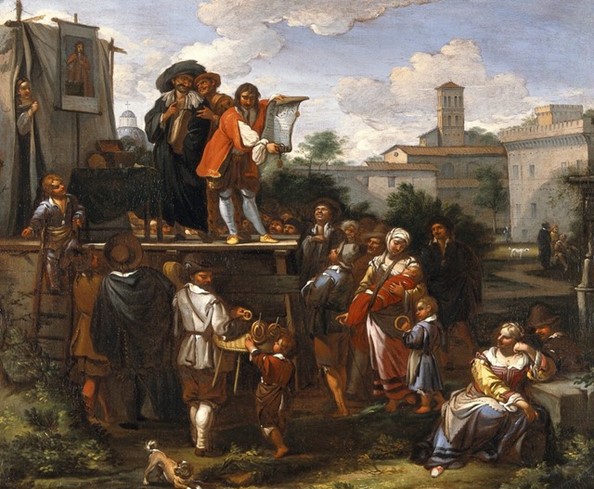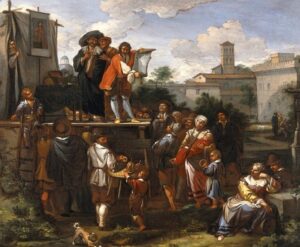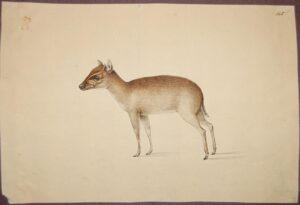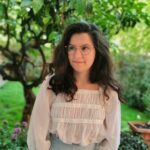
As crucial actors in the transmission of non-Western medical and botanical knowledge, itinerant medicine sellers joined the vibrant medical marketplace of early modern Europe, selling tobacco, Lemnian clay, civet and musk...
Early modern people were familiar with all sorts of travelling medical substances. In Europe, changes in trade and consumption patterns allowed an increasing number of contemporaries to engage with exotic ingredients from Asia and the Americas. These exotic substances were sometimes accompanied by displaced non-Europeans that have long remained invisible in the history of science and medicine. These foreigners played a vital role in teaching early modern Europeans how to handle new materia medica. As crucial actors in the transmission of non-Western medical and botanical knowledge, they sometimes joined the vibrant medical marketplace of early modern Europe. For example, in cosmopolitan Italian port towns, people from the Eastern Mediterranean, Levant, and North Africa were active as medicine vendors, vernacular practitioners, and magical healers.
Marc’Antonio Galeoto
One of them was Marc’Antonio Galeoto from Jerusalem, an itinerant vendor of medicinal plants (‘simplicista Jerosolimitano’), who petitioned the Venetian Health Office in 1591 (ASVe, Provveditori alla Sanità, 736, 63v). Marc’Antonio was hoping to obtain a license for selling medical simples across the Venetian Republic. He presented the Health Office with a self-drafted inventory of his goods: The list featured twenty-four medicinal ingredients, of which several would have been sourced in the Eastern Mediterranean, the Levant, or the Indian subcontinent. The list included highly sought-after substances such as terra lemnia (clay from the Ottoman-Greek island of Lemnos), imperatina from India (an Asian grass named after the botanist Ferrante Imperato, b.1525), and spigo nardus (a lavender-like spike from India, also known as Nardus Indica).

Dirk Helmbreker (attrib.), Itinerant Medicine Vendors in Rome, before 1696, oil on canvas, 60 x 74 cm, London, Wellcome Collection, 45032i.
As was often the case for contemporary street vendors, pedlars, and charlatans, Marc’Antonio’s identity remains slippery. His surname may indicate that he was one of the many free galeotti, enlisted galley oarsmen, that the Venetian Republic recruited from the Stato da Mar (Venice’s oversees dominions in the Adriatic, Ionian, and Aegean Sea) and the broader Eastern Mediterranean. The geographical ascription ‘from Jerusalem’ (‘Jerosolimitano’) may also suggest that Marc’Antonio came, in fact, from the Eastern Mediterranean and had reached the Italian peninsula like many Ottoman Christians, renegades, and enslaved people before him. He may also have been one of the several early modern travellers and seamen who embarked on adventurous journeys and consequently adopted exoticizing nicknames. Finally, he might have belonged to the many itinerant medicine sellers who chose unique nicknames to stand out from the competition.
Michele di Giovanni
For some foreigners from the Eastern Mediterranean, itinerant medicine-selling could have become a particularly attractive occupation. In fact, Marc’Antonio was not the only (possibly) non-Western itinerant seller of exotic materia medica in early modern Italy. In 1634, Michele di Giovanni, an itinerant vendor from Ottoman-Greek Nafplio (‘Napoli di Romania’) in the Eastern Peloponnese, requested a license for selling medicinal ingredients from the apothecary’s guild in Siena (ASSi, Arti, 139, 39v). Like Marc’Antonio Galeoto, Michele di Giovanni was an itinerant vendor who specialised in exotic substances and drugs. He sold musk (‘Musco’), civet (‘Zibetto’), and tobacco in powdered and compact form (‘Tabacco pesto, e sodo’). The guild examined the substances and, finding them of low quality (‘non trovate buone’), decided to reject his request.

A Musk deer (Moschus) (?), in an album originally containing 167 drawings of quadrupeds; standing in profile to left
Watercolour, over graphite. C18th. British Museum. SL,5261.105.
Two of the three substances sold by Michele were expensive animal-sourced ingredients imported from Asia: civet and musk. In early modern Europe, these strongly scented substances were used in perfumery (often alongside ambergris) to stabilise the more ephemeral scents of flowers or craft fashionable scented accessories such as gloves, beads, and buttons. Musk and civet were essentials in the shops of Italy’s muschieri, artisans who specialised in the making and selling of perfumes and scented goods. Furthermore, the two substances also prominently featured in manuscript recipes books and printed artisanal manuals. Street vendors like Michele di Giovanni might have thus catered to the many amateurs who read similar how-to manuals and experimented with at-home perfume-making.
On the medical market of early modern Italy, exotic materia medica of varying qualities and prices was widely available. Contemporaries could have purchased foreign substances from a wide range of medical experts, such as apothecaries, artisans, or street vendors. In their engagement with exotic materia medica, Italian buyers might have also sometimes interacted with non-European individuals. In fact, importing foreign medical ingredients to Europe often required complex chains of cross-cultural transactions and mediations. The street vendors Marc’Antonio Galeoto from Jerusalem and Michele di Giovanni from Ottoman-Greek Nafplio probably never participated in long-distance trade and wholesaling across the Mediterranean and Eurasia. However, they might have played a crucial role in the small-scale everyday encounters and first-hand experiences of local buyers with migrating materia medica.
References
Mackenzie Cooley and Kathryn Biedermann, “Ambergris: From Sea to Scent in Renaissance Italy”, in: Mackenzie Cooley, Anna Toledano and Duygu Yıldırım (eds.), Natural Things in early modern Worlds (London and New York: Routledge, 2023), 111-135.
David Gentilcore, Medical Charlatanism in Early Modern Italy (Oxford and New York: Oxford University Press, 2006).
Sabrina Minuzzi, Sul filo dei segreti medicinali: praticanti e professionisti del mercato della cura a Venezia (secolo XVI-XVIII) (PhD Dissertation, University of Verona, 2008), https://iris.univr.it/retrieve/handle/11562/397742/5355/sabrina_minuzzi_tesi%20rid.pdf (last accessed 25/08/2023).
Cesare Santus, Il “turco” a Livorno: Incontri con l’Islam nella Toscana del Seicento (Milan: Officina Libraria, 2019), Chapter 4.
Evelyn Welch, “Scented Buttons and Perfumed Gloves: Smelling Things in Renaissance Italy”, in: M. Bella Mirabella (ed.), Ornamentalism: The Art of Renaissance Accessories (Ann Arbor: University of Michigan Press, 2011), 13-39.
Author

Lavinia Gambini is a third-year PhD student at Jesus College, University of Cambridge. Her PhD projects asks how non-Western/non-European foreigners (especially from the Eastern Mediterranean) intervened in the sphere of vernacular science and medicine of early modern Italy (1550-1669). She is particularly interested in how these often-displaced individuals could make a living as vernacular practitioners, healers, remedy-makers, and street vendors.
Twitter: @GambiniLavinia